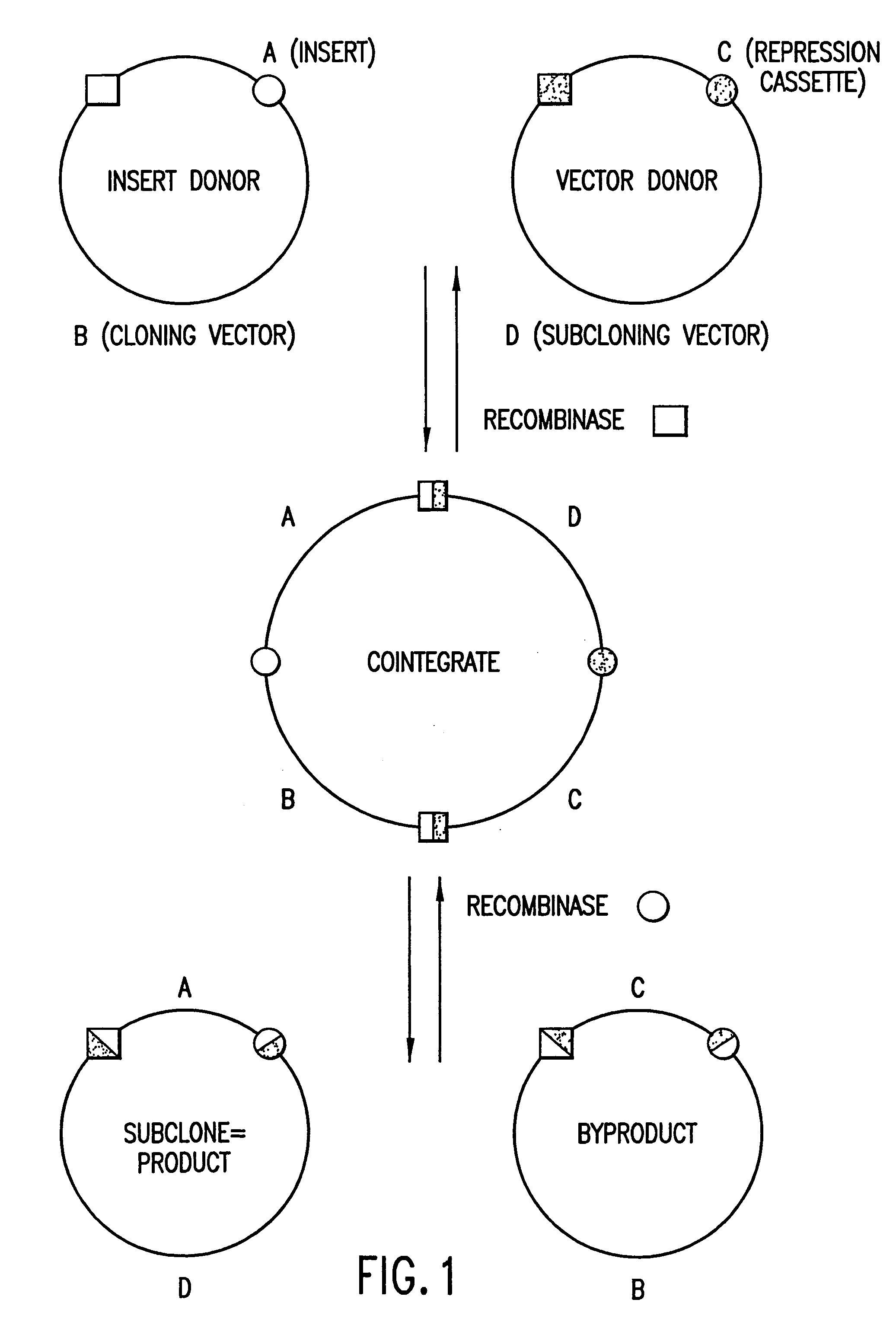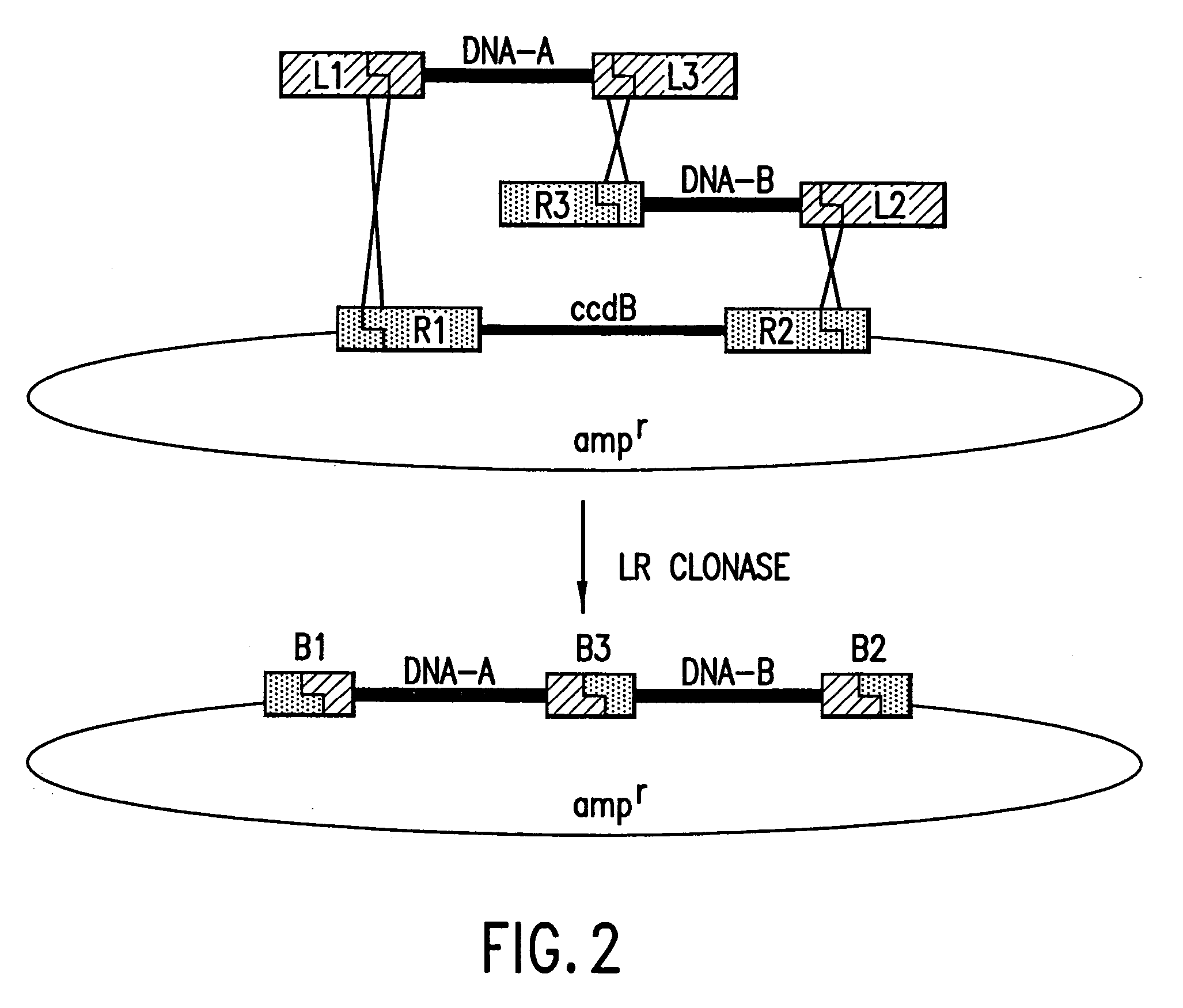Methods and compositions for synthesis of nucleic acid molecules using multiple recognition sites
a nucleic acid molecule and recognition site technology, applied in the field of biotechnology and molecular biology, can solve the problems of toxic genes, many other subclonings can take several weeks, and many other subclonings involve unknown sequences,
- Summary
- Abstract
- Description
- Claims
- Application Information
AI Technical Summary
Benefits of technology
Problems solved by technology
Method used
Image
Examples
example 1
Construction of Covalently Linked Double Stranded Recombinant Nucleic Acid Molecules Using Topoisomerase
[0497]This example demonstrates that topoisomerase can be used to produce covalently linked double stranded (ds) recombinant nucleic acid molecules.
A. Methods
[0498]Except where indicated, studies were performed using the following methods. PCR was performed in 50 μl reactions, including 10 ng plasmid (template), 100 ng each primer, 2.5 Units Taq DNA polymerase (Sigma), 5 μl 10× PCR buffer, and 4 μl of dNTPs (200 μM each). An initial denaturation was performed by incubating the reaction at 94° C. for 4 min; followed by 30 cycles of PCR using 94° C. (45 sec) for denaturation, 55° C. (45 sec) for primer annealing and 72° C. (1 min per kb of target sequence) for extension. After cycling, the reactions were incubated at 72° C. (10 min), and then placed at 4° C.
[0499]Topoisomerase joining reactions were performed in 5 μl, including 50–100 ng each amplified element (PCR-generated or synt...
example 2
Functional Characterization of Topoisomerase-generated ds Recombinant Nucleic Acid Molecules
[0504]This example demonstrates that a method of the invention provides a means to generate functional ds recombinant nucleic acid molecules covalently linked in both strands.
A. Expression of Sense and Antisense mRNA from a Topo-Ligated Construct
[0505]The ability to create a ds recombinant nucleic acid molecule containing functional upstream and downstream elements flanking a gene of interest was examined using two synthetic elements containing either a T7 or a T3 promoter sequence. The elements were made by annealing pairs of synthetic oligonucleotides. The T7 linker was generated by mixing equal molar amounts of T7top (F9304; SEQ ID NO: 20) and T7bottom (F9305; SEQ ID NO: 21) oligonucleotides (FIG. 9D). The T3 linker was generated by mixing equal molar amounts of T3top (F9661; SEQ ID NO: 23) and T3bottom (F9662; SEQ ID NO: 24) oligonucleotides (FIG. 9D). The mixtures were heated in boiling ...
example 3
[0514]Production and Use of Directionally Topo-Charged Gateway Vectors Introduction
[0515]As a combination of Topoisomerase and GATEWAY™ recombinational cloning technologies, directionally Topo-charged Gateway vectors were developed. These tools facilitate easy entry into the Gateway system by alleviating the necessity of adding attB sites (25 base pairs) to either side of a PCR amplified ORF prior to recombination into a Donor vector. Instead, a four base tag recognition sequence (CACC) is added to the 5′ end of the ORF and PCR products are then directionally TOPO-cloned to create an Entry or a Gateway compatible expression vector (See FIG. 29).
[0516]In the present Example, three Topo-Gateway vectors and one Destination vector were created in all. Two topo entry vectors have been produced: (1) pENTR / D-TOPO® (FIG. 22), which allows ORFs directionally cloned between attL sites to be transferred to any of the N-terminal fusion prokaryotic and all of the eukaryotic DEST vectors; and (2)...
PUM
| Property | Measurement | Unit |
|---|---|---|
| Time | aaaaa | aaaaa |
| Recombination enthalpy | aaaaa | aaaaa |
Abstract
Description
Claims
Application Information
 Login to View More
Login to View More - R&D
- Intellectual Property
- Life Sciences
- Materials
- Tech Scout
- Unparalleled Data Quality
- Higher Quality Content
- 60% Fewer Hallucinations
Browse by: Latest US Patents, China's latest patents, Technical Efficacy Thesaurus, Application Domain, Technology Topic, Popular Technical Reports.
© 2025 PatSnap. All rights reserved.Legal|Privacy policy|Modern Slavery Act Transparency Statement|Sitemap|About US| Contact US: help@patsnap.com



